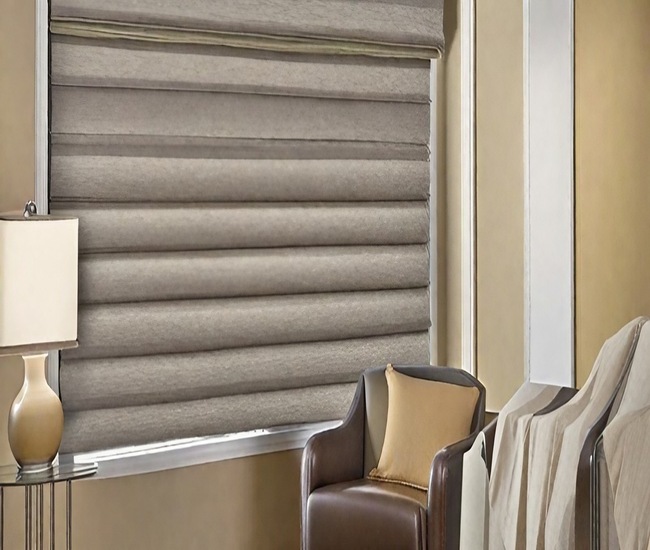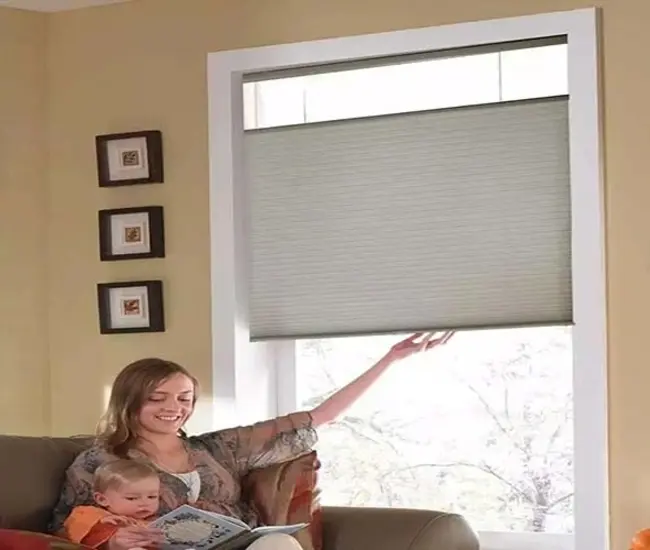Curious about honeycomb blinds? Read this post to explore the pros and cons of honeycomb blinds, a popular window treatment choice. While honeycomb blinds provide insulation, privacy, and light control, they do have their downsides, such as difficulty in keeping them clean.
Also called cellular blinds or thermal shades, honeycomb blinds are made of an interconnected series of cells that trap air to create an excellent insulation barrier. They also help in filtering the harsh sunlight.
Honeycomb blinds are available in both single cell and double cell designs. There are certain factors worth considering when selecting these popular window treatments for your home. In this buying guide for honeycomb blinds, you’ll discover their benefits and considerations for your home.
If you’re unsure whether cellular or honeycomb blinds are the right choice for your home, read this comprehensive guide on advantages and disadvantages of honeycomb blinds.
Advantages of Honeycomb Blinds
Honeycomb blinds are one of the most popular and functionally diverse window treatments for homes, offices, and other spaces. They provide a huge variety of advantages, from insulation to light control to privacy and beyond. They are a practical window treatment option for your home in terms of both curb appeal and functional potential.
100% Insulation
Honeycomb blinds are made of air-trapping cellular design to provide supreme insulation compared to other types of window treatments on the market. They block out heat when the summer rolls around. Also, they can keep cold air out during the winter months.
They are constructed with a series of fabric cells that work to trap air, creating an excellent insulating layer.
The great thing about insulation is that it can help cut down on energy costs. Forget about having to run your air conditioner all day, every day, throughout the summer.
Modern Design with a Slim Profile to Insulate Low-Depth Windows
Cellular shades and blinds are made with a slim profile. They don’t require a lot of depth to work well either. When you raise the fabric on honeycomb blinds, they simply fold up against the top of the window, completely out of the way. Whether you want the look of sleek, modern blinds or a wide-open window, honeycomb blinds can get the job done.
Blackout Feature
When you purchase them in light-filtering or blackout, they block light extremely efficiently compared to other types of window treatments on the market.
The reason they block out light so well is that they are made up of multiple layers of fabric, making it difficult to look through them if you are standing on the outside.
Tons of Privacy
Not only do honeycomb blinds provide users with great insulation properties, but they also provide them with greater privacy. For those looking for a private bedroom or den experience, honeycomb blinds are a wonderful choice.
If you want additional levels of privacy, we recommend selecting a double-cell option, as double-cell construction provides a much thicker build.
Noise Cancellation

If you decide to go for double-cell honeycomb blinds or honeycomb blinds with thicker fabrics, you have a better chance at canceling outside noise. If you have a home theater, home studio, or bedroom, having that added noise cancellation can be a treat. You can turn your home into a zen space with a simple window treatment!
Cordless Option

Honeycomb blinds are also available with a cordless lift option. Cordless lift system is an advanced safety feature for homes with young children and pets. Also, cordless honeycomb shades and blinds are quite quick and convenient to operate, i.e., raise, lower, and adjust for the required amount of light and privacy.
Affordability

Honeycomb blinds are an affordable window treatment option compared to curtains, shades, and draperies. For example, while a sheer shade costs over $100, you can buy a honeycomb blinds for just $42 for the same size window.
What are the cons of honeycomb shades?
While there are multifaceted benefits of honeycomb blinds, including energy efficiency, noise cancellation, and safety features, you need to understand their few drawbacks when shopping for them.
Difficulty in Cleaning

Because of their complex and intricate design, honeycomb blinds are a bit difficult to clean compared to other window treatments, such as plastic or wood blinds, curtains, vertical blinds, and shutters.
Less Durable
Honeycomb blinds are less durable than Roman shades and shutters.
How to DIY Install Honeycomb Blinds for Better Fit and Function

Here are some DIY steps to install honeycomb blinds for maximum insulation, light control, privacy, and other benefits.
Gather Tools & Materials

You will need a drill, a steel measuring tape, a pencil, a level, screws, and brackets.
Measure your Window Frame

Measure your window frame to determine the size of the cellular blinds you will need. Honeycomb blinds come in many sizes and configurations, so make sure to choose the right one for your windows.
Mount the Brackets

Hold the mounting brackets up to the top of your window’s frame, making sure they are level. Use a pencil to mark the location of the holes for screws. Drill pilot holes, and attach the brackets to the frame using screws.
Attach the Cord Cleats (if applicable)
Cord cleats are small hooks that hold the lift cords in place. Attach them to your window’s frame or nearby wall at a height that is out of reach of children or pets.
Test Your Honeycomb Blinds’ Operation and Function
Pull the lift cords or use the cordless lift option to raise, lower, and adjust the height of honeycomb blinds. Make sure they operate smoothly and stay in place for better light control, insulation, and other benefits.
Operation and Maintenance
Honeycomb blinds and shades can be operated with the help of different lift options, such as cord, cordless, continuous cord loop, motorized, and smart lifts. However, their dust-collecting cells are a bit difficult to clean. You can keep them clean by dusting, vacuuming, spot cleaning, and washing.
Where to Buy Affordable Honeycomb Blinds

At Affordable Blinds online store, you can buy high-quality, yet budget-saving honeycomb blinds. Make sure to look at our Latest Cordless Honeycomb Blinds collection and choose the perfect style and color for your home’s windows.
FAQs
Are honeycomb shades outdated?
No. Honeycomb blinds are still in style, as you can hang them on any windows throughout your home. Top-down/bottom-up design and layering with an opaque liner and sheer shades give cellular shades maximum versatility.
Are honeycomb blinds hard to keep clean?
Yes, honeycomb blinds are not as easy to clean as plastic or wood blinds. The cellular fabric collects dust and dirt and can even stain over time.
Do honeycomb blinds insulate well?
Also called thermal cell blinds, honeycomb blinds are designed to trap and conserve air, retaining warmth and keeping the cold out. Efficient honeycomb construction produces a similar insulating effect to double glazing at a much cheaper cost.
Should I switch to insulated curtains or honeycomb blinds?
Typically honeycomb blinds are better for retaining heat in your home. While thermal curtains can reduce heat loss by just 25% to 30%, insulating honeycomb blinds can reduce heat loss from your home by up to 40%. Also, honeycomb blinds are an affordable option to insulate your windows.
Are honeycomb blinds worth the money?
The answer is yes! Honeycomb blinds are the most thermally-efficient and cost-effective window furnishings around. They are available in single cell blackout and double-cell light filtering fabrics. Both types improve the energy efficiency of your home.
Are insulating blinds worth it?
Yes! Insulating blinds with a honeycomb construction, thermal lining or insulation layer can reduce heat loss in winter by up to 40% and prevent heat gain inside your home by up to 77%, saving you a huge amount of money on your rising energy bills round the year.
Need More Help?
Want to know more about the pros, cons, and insulation potential of honeycomb blinds? Get in touch for free consultation! Use 24/7 live chat or give us a call at (800) 863-6109 to contact our experts for DIY honeycomb shade solutions.
